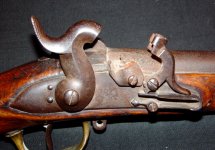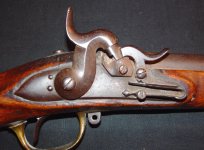daveatjohnx
New member
After 55 years collecting and dealing in antique firearms I have found one I've never seen. Can anyone help me identify this unique conversion? The lock is on a 1/2 Scale 69 cal. musket that looks to be either French, Belgian or perhaps Austrian.
Here are a couple of photos of the lock:
http://s264.photobucket.com/user/da...n Artifacts/DSC04817_zpszjtj6znd.jpg.html?o=1
http://s264.photobucket.com/user/da...acts/DSC04818_zpsxdxy6crn.jpg.html?sort=3&o=0
Here are a couple of photos of the lock:
http://s264.photobucket.com/user/da...n Artifacts/DSC04817_zpszjtj6znd.jpg.html?o=1
http://s264.photobucket.com/user/da...acts/DSC04818_zpsxdxy6crn.jpg.html?sort=3&o=0



